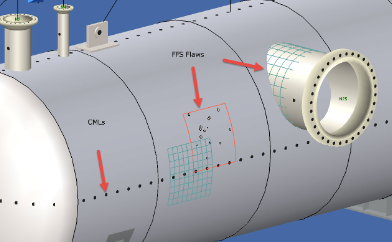Are you familiar with API 510 pressure vessels? As a professional in the industry, it’s important to understand their significance and potential risks.
In this article, we will explore the different types of defects found in API 510 pressure vessels, their causes, and the importance of regular inspections and testing.
Key Takeaways
– Regular inspections and testing are crucial for identifying defects in API 510 pressure vessels.
– Non-destructive testing techniques such as eddy current and ultrasonic are used to identify defects.
– Risk-based inspection strategies prioritize potential issues based on vessel age, previous results, operating conditions, and materials used.
– Effective repair and maintenance procedures by experienced professionals with API 510 knowledge are crucial for maintaining vessel integrity.
Understanding API 510 Pressure Vessels and Their Importance
API 510 pressure vessels are crucial components of industrial equipment, and understanding their importance is key to identifying potential defects.
These regulations require thorough inspections of the vessels on a regular basis to identify any defects that could compromise their safety. Defects can range from cracks, corrosion, leaks, deformation, or other forms of damage that can affect the structural integrity of the vessel. Understanding these potential defects is critical for maintaining safe operations within an industrial facility.
Moving forward into the subsequent section about common types of defects found in API 510 pressure vessels…
Common Types of Defects Found in API 510 Pressure Vessels
You may be surprised to learn about the frequent issues that arise in pressure vessels during inspections, causing potential safety hazards and impacting performance.
Some of the most common types of defects found in these vessels include corrosion, deformation, cracking, and leaks. Corrosion is a major concern because it can weaken the structural integrity of the vessel and lead to failure under pressure. Cracks can develop from stress points or material fatigue, while leaks can occur at welded seams or connections.
It is important to identify these defects early on during inspections and take necessary measures for repair or replacement. With proper defect prevention and quality assurance practices in place, many of these issues can be avoided altogether.
As we move forward into exploring the causes of defects in API 510 pressure vessels, it is important to keep in mind that understanding these causes can help us prevent future occurrences of similar defects. By exploring the types of defects commonly found in pressure vessels, we can identify the root causes and implement effective preventive measures.
Causes of Defects in API 510 Pressure Vessels
Let’s dive into what can cause defects in pressure vessels and how we can prevent them.
– Poor welding techniques: Welding is a crucial process that requires skill and precision. Any improper welding technique can result in weak spots, cracks, or incomplete welds that lead to structural failure.
– Corrosion: Over time, exposure to harsh chemicals, high temperatures, and moisture can corrode the metal surface of a pressure vessel. This corrosion weakens the structure and may lead to leaks or ruptures.
– Fatigue: This results in small cracks on the surface that can grow over time if not detected early.
– Improper maintenance: Lack of regular inspections and preventive measures such as cleaning, calibration, and repairs can lead to undetected defects in pressure vessels.
– Material defects: Any material defect such as impurities or incorrect composition may result in structural weakness.
To prevent these defects from occurring, it’s important to use proper welding techniques during fabrication and ensure regular maintenance through inspections and preventive measures. Regular testing is also crucial for ensuring that the equipment meets industry standards.
Next up, let’s explore the importance of regular inspections and testing for API 510 Pressure Vessels.
Importance of Regular Inspections and Testing
Regular inspections and testing are crucial to ensure the safe operation of API 510 pressure vessels. Risk-based inspection strategies also play a key role in identifying critical areas that require more frequent and thorough inspections.
Additionally, proper repair and maintenance procedures must be implemented to address any issues found during inspections and prevent further deterioration of the equipment.
Non-Destructive Testing Techniques
Using non-destructive testing techniques can help you identify defects in API 510 pressure vessels without compromising their integrity or safety. Eddy current and ultrasonic testing are two common methods that allow inspectors to detect flaws, cracks, and corrosion in the vessel walls without having to dismantle it.
Eddy current testing involves passing an electrical current through a coil that generates a magnetic field around the vessel wall. The magnetic field produces eddy currents, which react with any defects present on the surface of the material and cause changes in the electrical resistance of the coil.
By analyzing these reflected waves, inspectors can determine the size and location of any defects inside the vessel.
Non-destructive testing techniques are essential for maintaining safe operations of API 510 pressure vessels. However, detecting potential issues is only part of ensuring safety: risk-based inspection strategies must also be implemented to address identified risks effectively.
Risk-Based Inspection Strategies
Inspection intervals should be based on several factors, including vessel age, previous inspection results, operating conditions, materials used in construction, and other relevant data. By analyzing this information and using it to develop an effective risk-based inspection strategy, you can maximize your resources while minimizing downtime and disruptions to your operations.
Implementing such a strategy requires careful planning, but the benefits are significant in terms of ensuring safety and reducing costs associated with unplanned maintenance activities.
Repair and Maintenance Procedures
Maintaining the integrity of your equipment is crucial, so it’s important that you take the time to understand and implement effective repair and maintenance procedures.
When it comes to repairing pressure vessels, there are several methods that can be used depending on the type of defect. For example, if a vessel has a small crack or hole, welding techniques such as gas tungsten arc welding (GTAW) or shielded metal arc welding (SMAW) may be used to repair the defect.
However, for more severe defects such as corrosion or pitting, more extensive repairs may be necessary. In these cases, it may be necessary to replace entire sections of the vessel or even the entire vessel itself.
It’s important to work with experienced professionals who have a deep understanding of API 510 standards and can recommend appropriate repair methods based on the specific type of defect found in your pressure vessel.
With proper repair and maintenance procedures in place, you can ensure that your pressure vessels remain safe and reliable for years to come.
This includes regular inspections and testing as well as implementing preventative maintenance measures to catch potential issues before they become major problems.
By staying proactive about maintaining your equipment, you can avoid costly downtime due to unexpected failures while also keeping your employees safe from potential hazards associated with malfunctioning pressure vessels.
Best Practices in Maintaining the Safety and Reliability about API 510 Pressure Vessels
You can ensure the safety and reliability of API 510 pressure vessels by implementing best practices. Here are three recommended preventive measures that should be part of your safety protocols:
1. Regular inspections: Conducting regular visual inspections, thickness measurements, and non-destructive testing (NDT) is essential in identifying defects before they become a major issue. Inspections should be done at least once every five years or as specified by the manufacturer.
2. Complete maintenance: This includes following proper cleaning procedures, repairing any damage immediately, and replacing worn-out parts as needed.
3. Documented procedures: Having documented procedures for both inspection and maintenance activities ensures consistency in work processes, maintains quality standards, and establishes accountability within the organization.
By implementing these best practices, you not only ensure the safety of your personnel but also prolong the life of your API 510 pressure vessel while reducing downtime due to unplanned maintenance activities.
Remember that prevention is always better than cure when it comes to maintaining equipment that plays a critical role in industrial operations.
Conclusion
In conclusion, understanding the types of defects found in API 510 pressure vessels is critical for ensuring their safety and reliability. As a user, it’s important to know that common types of defects include corrosion, cracking, distortion, and erosion. These defects can be caused by various factors such as exposure to harsh chemicals or high pressure.
Regular inspections and testing are essential for identifying any potential issues before they become major problems. It’s also necessary to follow best practices for maintaining the safety and reliability of API 510 pressure vessels. This includes proper cleaning and maintenance procedures, conducting regular inspections, using appropriate materials and equipment, and following industry standards and regulations.
By taking these steps to maintain the integrity of API 510 pressure vessels, you can ensure their safe operation while minimizing the risk of accidents or failures. Remember that prevention is key when it comes to preventing defects in pressure vessels – so stay vigilant, stay informed, and prioritize safety at all times.





 Black Mirrors Nguyen Si Kha • Always August • 2022
Black Mirrors Nguyen Si Kha • Always August • 2022